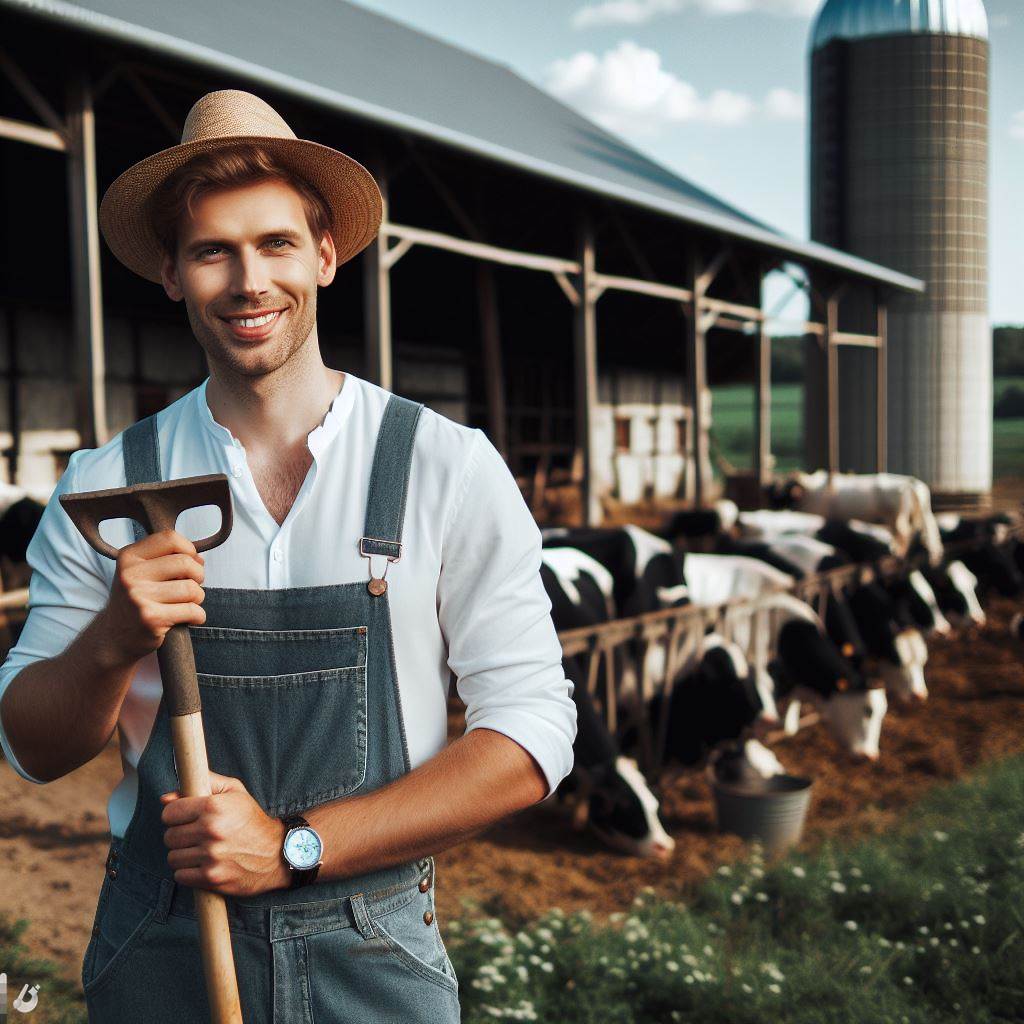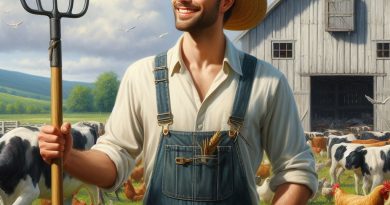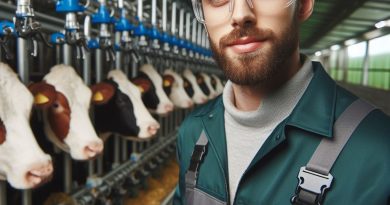Innovations in Dairy Cattle Management
Last Updated on January 24, 2024
Introduction
Dairy cattle management plays a crucial role in the farming industry, ensuring productivity and profitability.
This blog post provides a brief overview of the innovations in dairy cattle management.
Proper management of dairy cattle is essential for farmers to maximize milk production and maintain herd health.
Effective strategies improve efficiency and reduce costs.
Healthy cows directly impact milk quality and quantity, leading to increased profits for dairy farmers.
To achieve optimal results, farmers utilize innovative management techniques to monitor and enhance various aspects of dairy cattle farming.
Innovations in dairy cattle management have revolutionized the industry, providing farmers with advanced tools and methods.
Technological advancements, such as automated milking systems and computerized monitoring, have streamlined processes and improved efficiency.
Precision feeding practices based on individual cow needs have optimized nutrition and minimized wastage.
Farmers now utilize data-driven decision-making, incorporating genetics, reproductive technologies, and health monitoring to increase overall profitability.
Innovations in housing have enhanced cow comfort, reducing stress and improving overall well-being.
Efficient waste management systems help maintain a sustainable and environmentally friendly operation.
In short, dairy cattle management is crucial for the farming industry’s success, ensuring the productivity and well-being of cows.
Innovative practices have revolutionized the industry, enabling farmers to achieve maximum efficiency, profitability, and sustainability.
Embracing these advancements empowers farmers to adapt to a rapidly changing agricultural landscape.
Improvements in Health Monitoring
Advances in technology for monitoring the health of dairy cattle
Advances in technology have significantly enhanced the management of dairy cattle by allowing for more accurate and efficient health monitoring.
This has led to numerous benefits, including early detection and prevention of diseases, ultimately improving the overall well-being and productivity of dairy herds.
Benefits of Early Detection and Prevention of Diseases
Early detection and prevention of diseases is crucial in maintaining the health of dairy cattle.
By promptly identifying any signs of illness, farmers can take immediate action to treat the affected animal, reducing the spread of diseases within the herd.
Early detection also minimizes the risk of severe complications and potential economic losses.
Timely intervention allows for less invasive and less expensive treatments, increasing the chances of a successful recovery and reducing overall veterinary costs.
Examples of Innovative Health Monitoring Tools
Various innovative tools have been developed to facilitate health monitoring in dairy cattle.
These advancements enable farmers to continuously track and evaluate the well-being of their animals, ensuring timely intervention when needed.
Activity Monitoring Systems
Activity monitoring systems utilize sensors placed on the animals to monitor their movement and behavior patterns.
These sensors can detect changes in activity levels, which might indicate health issues such as lameness or estrus.
The data collected by these systems is then analyzed using sophisticated algorithms, providing farmers with valuable insights into the health status of individual cows.
By identifying deviations from normal behavior, farmers can take proactive measures to address potential health problems.
Rumination Monitoring Devices
Rumination monitoring devices track the chewing and rumination activity of dairy cattle.
Changes in rumination behavior can signify various health issues, such as digestive disorders or suboptimal feed intake.
These devices are typically attached to the cow’s ear or neck and continuously measure rumination activity.
By monitoring rumination patterns, farmers can identify cows that require attention and implement appropriate management interventions, ensuring optimal rumen function and overall health.
Temperature and Health Sensors
Modern dairy farms employ temperature and health sensors to monitor the body temperature and overall health of cows.
These sensors can detect early signs of diseases such as mastitis or respiratory infections.
The sensors are often placed on the cow’s ear or neck and provide real-time data on temperature, activity levels, and rumination behavior.
This information allows farmers to detect abnormalities quickly and take proactive measures to prevent further complications.
Data Analytics and Integration
- Advancements in data analytics and integration have revolutionized dairy cattle management.
- By integrating data from various health monitoring tools, farmers can obtain a comprehensive understanding of their herd’s health status.
- Sophisticated software platforms analyze the collected data, providing actionable insights and recommendations.
- This allows farmers to make informed decisions regarding individual animal care, reproduction management, and overall herd health optimization.
In summary, Innovations in dairy cattle health monitoring have greatly improved the well-being and productivity of dairy herds.
The advent of activity monitoring systems, rumination monitoring devices, temperature and health sensors, and data analytics has empowered farmers to detect and prevent diseases at an early stage.
By leveraging these innovative tools, farmers can ensure timely intervention and minimize the impact of illnesses on their herds.
Ultimately, these advancements contribute to the sustainable and efficient management of dairy cattle, benefitting both the animals and the farmers.
Read: Managing Cattle: Disease Prevention Tips
Efficiency in Feeding and Nutrition
Proper nutrition is crucial for dairy cattle as it directly impacts their productivity and overall health.
Innovations in feed composition and formulation have revolutionized the dairy industry.
Moreover, technologies that automatically adjust feed rations based on individual needs have further optimized feeding practices.
Importance of Proper Nutrition for Dairy Cattle
Proper nutrition plays a vital role in the overall well-being of dairy cattle. It directly affects milk production, reproductive efficiency, and the health of these animals.
Nutrient requirements vary based on factors such as age, weight, breed, and lactation stage.
Therefore, providing the right balance of nutrients is essential to maximize productivity and maintain optimal animal health.
Innovations in Feed Composition and Formulation
Advancements in feed composition and formulation have greatly improved the nutritional value of dairy cattle diets.
The development of specialized feed additives such as probiotics, prebiotics, and enzymes has significantly enhanced animal digestion and nutrient absorption.
These additives promote gut health and improve the efficiency of feed utilization, resulting in increased milk production.
Furthermore, precision feeding has emerged as an innovative approach to optimize nutrient utilization.
This technique involves formulating feed rations with the right balance of energy, protein, vitamins, and minerals to meet individual animal requirements.
Precision feeding not only improves milk yield but also reduces feed wastage and environmental impact.
Technologies for Automatically Adjusting Feed Rations
To ensure dairy cattle receive precise and timely nutrition, technologies for automatically adjusting feed rations have been developed.
These innovative tools utilize sensors and data analysis to monitor individual animal needs.
Feed management software collects information on milk production, body condition, and weight, allowing the system to calculate and adjust the optimal feed ration for each animal.
Automated feeders equipped with individual identification systems can proportionally dispense the required feed based on real-time data.
This ensures that each animal receives the specific nutrients it needs, improving overall health and productivity.
Additionally, these systems have the potential to detect early signs of health issues by monitoring eating patterns and feed consumption deviations.
Benefits of Efficient Feeding and Nutrition Practices
- Efficient feeding and nutrition practices offer several benefits to dairy cattle producers.
- Firstly, optimizing feed utilization reduces production costs and allows farmers to allocate resources effectively.
- Secondly, it promotes better animal health and welfare, reducing the risk of diseases and enhancing reproductive outcomes.
- Thirdly, increased milk production and improved milk composition directly translate into higher profits for dairy farmers.
- Moreover, efficient feeding practices contribute to the sustainability of the dairy industry.
- By reducing feed wastage, producers can minimize environmental impacts associated with feed production and manure management.
- Furthermore, precision feeding and automated ration adjustments reduce the reliance on antibiotics and growth promoters, thus supporting sustainable and responsible farming practices.
In a nutshell, advancements in feeding and nutrition have revolutionized dairy cattle management.
Proper nutrition is essential for the productivity and health of dairy cattle.
Innovations in feed composition and formulation, along with technologies for automatic feed ration adjustments, have optimized feeding practices.
These advancements have led to increased milk production, improved animal health, and enhanced sustainability in the dairy industry.
Read: Deer Farming: Genetics for Superior Antlers
Automation and Robotics
The dairy industry has seen significant advancements in recent years, particularly in the field of automation and robotics.
These innovations have revolutionized the way dairy cattle are managed, providing numerous benefits to farmers and increasing efficiency in the process.
This section will explore the adoption of automation and robotics in dairy cattle management, the advantages of robotic milking systems, and the use of automated feeding and cleaning systems.
Adoption of automation and robotics in dairy cattle management
Automation and robotics have been increasingly adopted in dairy cattle management to streamline various tasks and improve overall farm productivity.
These technologies offer farmers the opportunity to optimize their operations and enhance animal welfare.
Benefits of robotic milking systems
Robotic milking systems have gained popularity in the dairy industry due to their numerous benefits.
These systems allow cows to be milked automatically, reducing the need for manual labor and providing round-the-clock milking.
With robotic milking systems, cows have the freedom to choose when to be milked, resulting in less stress for the animals.
Moreover, these systems can collect data on milk yield, udder health, and cow behavior, enabling farmers to make informed decisions and improve herd management.
Automated feeding and cleaning systems
Automation has also extended to feeding and cleaning systems in dairy cattle management.
Automated feeding systems ensure that cows receive precise and balanced nutrition, as the technology can tailor feed rations to individual cows’ needs.
This promotes better health and milk production. In addition, automated cleaning systems, such as robotic scrapers and automatic dung removers, help maintain hygiene in the barn and improve cattle comfort.
Increased efficiency and productivity
The integration of automation and robotics in dairy cattle management has significantly increased efficiency and productivity on farms.
With automated tasks, farmers can save precious time and allocate resources more efficiently.
Robots can perform monotonous and labor-intensive tasks, allowing farm workers to focus on other important aspects of herd management, such as animal health and welfare.
By reducing human error and optimizing processes, automation helps improve overall productivity and financial performance on dairy farms.
Enhanced animal welfare
- One of the most significant advantages of automation and robotics in dairy cattle management is the improvement of animal welfare.
- Robotic systems provide cows with increased autonomy and freedom of choice.
- For instance, with robotic milking systems, cows can decide when to be milked, eliminating the stress associated with scheduled milking.
- Additionally, automated feeding systems ensure that cows receive a balanced diet tailored to their individual needs, contributing to their overall health and well-being.
In essence, the adoption of automation and robotics in dairy cattle management has brought about significant advancements in the industry.
Robotic milking systems, automated feeding, and cleaning technologies have greatly improved efficiency, productivity, and animal welfare on dairy farms.
As technology continues to evolve, we can expect further innovations that will continue to revolutionize the way dairy cattle are managed, ensuring a sustainable and profitable future for the industry.
Read: Turkey Genetics: Raising Robust Birds

Precision Breeding and Genetic Selection
In dairy cattle management, genetics plays a crucial role in improving milk production and overall health.
Advancements in precision breeding techniques have revolutionized the industry, allowing for more targeted genetic selection.
Role of Genetics in Dairy Cattle Management
- Genetics determine the potential of a dairy cow in terms of milk production and overall health.
- Specific genes influence traits such as milk yield, fertility, longevity, and resistance to diseases.
- Understanding the genetic makeup of a cow helps farmers make informed breeding decisions.
Advancements in Precision Breeding Techniques
- Artificial insemination (AI) is widely used in precision breeding to introduce specific genetic traits.
- Semen from highly productive bulls can be collected, processed, and distributed to achieve desired genetic improvements.
- In vitro fertilization (IVF) allows for more efficient reproduction and the preservation of elite genetic material.
- Embryo transfer enables the reproduction of genetically superior cows by implanting fertilized embryos into recipient cows.
- Genomic selection, based on DNA analysis, identifies desirable traits at early stages in a cow’s life.
Utilization of Genetic Selection for Improved Milk Production and Overall Health
- Genetic selection is crucial to achieve higher milk yields, improved milk quality, and overall cow health.
- Farmers can select bulls with desired genetic traits to sire the next generation of dairy cows.
- By focusing on traits like milk yield, fat and protein content, farmers can enhance the profitability of their herds.
- Genetic selection also helps in breeding cows with increased resistance to diseases and better reproductive performance.
- Optimizing genetic potential through selection contributes to sustainable and efficient dairy farming practices.
In general, precision breeding and genetic selection have revolutionized dairy cattle management.
By understanding the role of genetics and utilizing advancements in precision breeding techniques, farmers can improve milk production, milk quality, and overall cow health.
Genetic selection allows for the careful consideration of desired traits, leading to sustainable and efficient dairy farming practices.
Embracing these innovations ensures a brighter future for the dairy industry.
Read: Llama & Alpaca Breeding: Genetic Tips
Environmental Sustainability
Innovations in waste management for dairy farms
- Adoption of anaerobic digestion systems to convert manure into biogas, reducing methane emissions and generating renewable energy.
- Utilization of solid-liquid separation techniques to extract solids from manure, making it easier to handle and reducing the risk of nutrient runoff.
Strategies for reducing the environmental impact of dairy cattle farming
- Implementation of precision feeding practices to minimize nutrient waste and improve feed efficiency, thus reducing the environmental footprint.
- Adoption of rotational grazing systems that allow for better pasture management, reducing the reliance on feed crops and conserving soil health.
- Utilization of cover crops to capture and recycle excess nutrients, preventing leaching and runoff into water bodies.
Sustainable practices for manure handling and nutrient utilization
- Injection or incorporation of manure into the soil to reduce odors, minimize nutrient losses, and improve soil fertility.
- Use of advanced technologies like nutrient management planning software to optimize fertilizer applications, avoiding excess nutrient inputs.
- Implementation of controlled-release fertilizers that slowly release nutrients over time, reducing the risk of nutrient runoff.
Moreover, dairy farms can also explore the following environmental sustainability initiatives:
Investing in renewable energy
- Installation of solar panels and wind turbines to generate clean electricity, reducing reliance on fossil fuels and decreasing greenhouse gas emissions.
- Utilization of geothermal systems for heating and cooling dairy facilities, minimizing energy consumption and carbon footprint.
Promoting water conservation
- Implementation of efficient irrigation systems and water-saving technologies to minimize water usage in crop production.
- Installation of rainwater harvesting systems to collect and store rainwater for various farm purposes, reducing reliance on groundwater resources.
Protecting biodiversity
- Establishment of riparian buffer zones along water bodies, preserving native vegetation and providing habitat for wildlife.
- Promotion of pollinator-friendly practices, such as planting wildflowers, to enhance pollination and support bee populations.
Encouraging sustainable packaging and waste reduction
- Adoption of eco-friendly packaging materials made from renewable resources or recyclable materials.
- Implementation of recycling programs to minimize waste generation and promote the reuse of materials.
Engaging in environmental education and outreach
- Conducting workshops and training programs for farmers to raise awareness about sustainable practices and their benefits.
- Collaborating with local communities and organizations to share knowledge and best practices, fostering a culture of environmental stewardship.
By embracing these innovations and practices, the dairy industry can enhance its environmental sustainability, minimize pollution, and contribute to a healthier planet for future generations.
Conclusion
In this blog post, we have explored various innovations in dairy cattle management that are shaping the industry.
These advancements have revolutionized the way dairy farms function, leading to increased efficiency and profitability.
We discussed the introduction of robotic milking systems, which have automated the milking process, reducing labor costs and improving cow comfort.
Additionally, the use of precision nutrition techniques has allowed farmers to tailor feed to individual cows, optimizing their health and milk production.
Another significant innovation covered was the implementation of advanced health monitoring systems.
By utilizing sensors and data analysis, farmers can monitor their cows’ vital signs and detect early signs of illness, leading to proactive healthcare management.
Furthermore, we explored potential future developments in dairy cattle management.
This includes the use of artificial intelligence and machine learning algorithms to further enhance decision-making on the farm.
The integration of smart technologies could revolutionize data-driven management practices.
Overall, the importance of continuous improvement for the dairy cattle industry cannot be understated.
These innovations not only benefit farmers by improving profitability and sustainability but also contribute to the well-being of the animals.
It is crucial to embrace new technologies and methods to stay competitive in the ever-evolving dairy industry.
By staying informed about emerging trends and fostering a culture of innovation, the dairy cattle management sector can continue to thrive and meet the growing demands of consumers worldwide.


